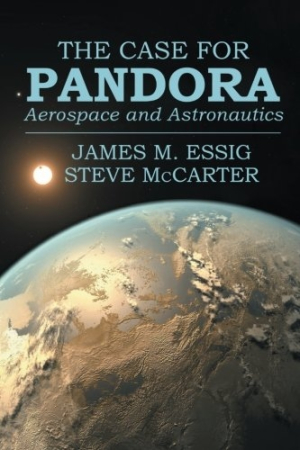The Case for Pandora
Aerospace and Astronautics
The Case for Pandora explores the capabilities of modern extraterrestrial travel technology with enthralling vision.
James Essig and Steve McCarter’s The Case For Pandora is a technical manual with instructions for building a spaceship capable of extraterrestrial travel. Designs for generation, colony, and century ships, collectively referred to as space arks, are offered as a solution to an extinction-level event (ELE) such as an asteroid or climate change.
The text is devoted to a single solution to human extinction: leaving Earth behind. It includes extensive information about building a colony ship, maintaining an artificial human-friendly environment on board, and supporting life in space, but this work is backed by only a cursory assessment of the motives for evacuating the planet. The introduction glosses over such motives, dismissing causes from politics and overcrowding without nuance. It is more thorough in covering the scientific aspects of space travel.
The book includes ship designs that focus on technical details and physical capability. These are covered in seven sections that go over information about materials, manufacturing considerations, and power and propulsion. The book’s thirty-six chapters include over 200 images and diagrams, most taken from NASA, the Department of Energy, and other legitimate sources. These cover liquid fuel rocket engines and their components. A chapter on the ark’s passengers addresses “both physical and psychological health, systems for shipboard governance, and reproduction and population control methods that are necessary to maintain a viable population capable of completing a mission that may take generations to accomplish.”
The work is organized in an easy-to-use way, and its tables and images help impart understanding. The text assumes a basic understanding of manufacturing, design, and physics, but explanations of the discussed principles make it accessible to laypeople, too. Conversational in tone, it uses accessible language to describe complex concepts from aerospace design and astronautics.
The book has in mind massive flying ships of the sort that would make Apollo 11 look like a tiny skiff. From an engineering perspective, its analysis of different interstellar crafts and technology is solid. It does not extend to including blueprints, but emphasizes what is possible in building and operating colony-sized spacecrafts. To existent conversations of space travel, it adds suggestions for building bigger, more powerful crafts with technology that is already available.
The Case for Pandora explores the capabilities of modern extraterrestrial travel technology with enthralling vision, talking in a realistic way about how to fulfill the timeless dream of a new Earth, self-sustaining and suspended in space.
Reviewed by
Claire Foster
Disclosure: This article is not an endorsement, but a review. The publisher of this book provided free copies of the book and paid a small fee to have their book reviewed by a professional reviewer. Foreword Reviews and Clarion Reviews make no guarantee that the publisher will receive a positive review. Foreword Magazine, Inc. is disclosing this in accordance with the Federal Trade Commission’s 16 CFR, Part 255.

